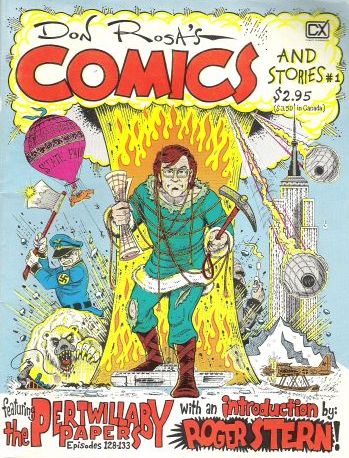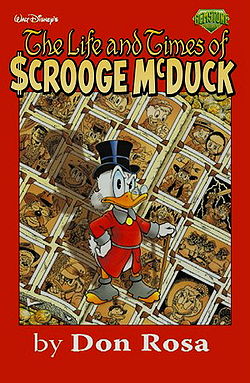
Working for Gladstone

Working for Egmont
In 1991 he started creating The Life and Times of Scrooge McDuck, a twelve
chapter story about his favorite character. The series was a huge success, and
in 1995 he won an Eisner Award for best continuing series. After the end of the
original series, Don started producing additional "missing" chapters. Some of
the extra chapters were turned down by Egmont because they were not interested
in any more episodes. Fortunately, the French publisher Picsou was eager to
publish the stories. From 1999, Don started working freelance for Picsou as
well. Some of these chapters were recently compiled as The Life and Times of
Scrooge McDuck Companion.
For more information on Don see:
Don Rosa
Biography
Keno Don
Hugo Rosa (generally just called Don Rosa) (born June 29, 1951) is an American
comic book writer and illustrator best known for his stories about Scrooge
McDuck, Donald Duck and other Disney characters. He was born in Louisville,
Kentucky, United States. His most
Don Rosa
In 1985, he discovered a Gladstone Publishing comic
book in the window of a small comic shop. This was the first American comic
book that contained Disney-characters after the 1970s. Since early childhood
Don Rosa had been fascinated by Disney stories about Donald Duck and Scrooge
McDuck. Artist Carl Barks was an especially big idol for him and would remain
so for the rest of his career. He immediately called the editor, Byron
Erickson, and told him that he was the only American who was born to write and
draw Scrooge McDuck comics. Byron agreed to let him send a story, and Don Rosa
started drawing his first Duck story: Son of the Sun the very next day.
Son of the Sun was a huge success and was nominated for a
Harvey Award. The plot of the story was exactly the same as his earlier story
Lost in (an alternative section of) the Andes. As Don Rosa formulated it, he
was just "(...) turning that old Pertwillaby Papers adventure back into the
story it originally was in my head, starring Scrooge, Donald, the nephews, and
Flintheart Glomgold."
Don Rosa did a few more comics for Gladstone till 1989.
He then stopped working for them because the policies of their licensor Disney
did not allow for the return of original art for a story to its creators. This
was unacceptable to Don Rosa, since a part of his income came from selling the
originals. Without that extra money, he could not make a living drawing comic
books.
After making some stories for the Dutch publisher Oberon,
the publishers of an American Disney children's magazine called DuckTales
(based on of the animated series of the same name) offered him employment. They
even offered him a much higher salary than the one he received at Gladstone.
Don made just one script (Back in Time for a Dime). The publishers never asked
him to make more, and due to problems with receiving the payment, he didn't
care.
His first real cartoon was a comic strip featuring
his own character, Lancelot Pertwillaby. He created the strip in 1971 for The
Kentucky Kernel, a college newspaper of the University of Kentucky which wanted
the strip to focus on political satire.
Rosa later talked them into letting him feature adventures
starring Lancelot Pertwillaby and drew the story Lost in (an alternative
section of) the Andes. (The title is a reference to Lost in the Andes!, a
Donald Duck story by Carl Barks, first published in April, 1949.) The so-called
Pertwillaby Papers included 127 published episodes by the time Rosa graduated.
Meanwhile Rosa participated in a fanzine. His
contribution was An Index of Uncle Scrooge Comics. According to his
introduction: "Scrooge being my favorite character in comic history and Barks
my favourite pure cartoonist, I'll try not to get carried away too much."
After receiving his bachelor degree, Rosa continued to
draw comics as a side job. He did not earn very much though from his creations.
His main source of income
came from working in the Keno Rosa Tile Company, a
company founded by his paternal grandfather and which had by that time been
taken over by Hugo Rosa.
Rosa authored and illustrated the monthly "Information
Center" column in the fanzine "The Rocket's Blast Comicollector" from 1974 to
1979. He also revived the Pertwillaby Papers from 1976 to 1978.
Rosa took a chance at more professional cartooning with
his creation of the comic strip character Captain Kentucky for the Saturday
edition of the local newspaper Louisville Times. Captain Kentucky was the
superhero alter ego of Lancelot Pertwillaby. Publication started on October 6,
1979. The comic strip ended on August 15, 1982 after the publication of 150
episodes. After three years with Captain Kentucky, Don decided that it was not
worth the effort. He retired from cartooning and did not draw a single line for
the next four years. Years later, as his fame grew, his non-Disney work was
published by the Norwegian publisher Gazette Bok in 2001, in the two hard-cover
books The Pertwillaby Papers and The Adventures of Captain Kentucky.

Comics
Brunner broke into comics as a horror writer-artist for the black-and-white
comics magazines Web of Horror, Creepy, Eerie and Vampirella. His best-known
color-comics work is his Marvel Comics collaboration with writer Steve
Engelhart on the supernatural hero Doctor Strange in Marvel Premiere from 1972
to 1973, and in Doctor Strange vol. 2, in 1974. Other Marvel credits include
the anthologies Chamber of Chills, Haunt of Horror, and Unknown Worlds of
Science Fiction; the supernatural series The Tomb of Dracula; the swamp-monster
series Man-Thing; and the science fiction series Silver Surfer and Howard the
Duck.
Also for Marvel, Brunner adapted Robert E. Howard's
sword-and-sorcery pulp fiction hero Conan the Barbarian in the 42-page story
"The Scarlet Citadel", and drew many covers for the similar series Red Sonja
and Savage Sword of Conan.
Brunner and novelist Michael Moorcock collaborated on a comics
adaptation of Moorcock's sword-and-sorcery hero Elric in Heavy Metal magazine.
It was reprinted in publisher Mike Friedrich's Star Reach Greatest Hits.
Brunner briefly returned to comics in the early-1980s as
artist on the First Comics title Warp, based on the science-fiction play that
ran briefly on Broadway in the 1970s. He then wrote and drew the graphic novel
The Seven Samuroid (1984), a science-fiction takeoff of the movie classic Seven
Samurai.
Film and television
Brunner moved to Hollywood and began a career in movie and television
animation, working on projects for Hanna-Barbera (Jonny Quest), Walt Disney
Imagineering (Euro Tomorrowland movie), Warner Bros. (preproduction Batman
design) and DreamWorks (Invasion USA). He was the head of character design for
the Fox animated series X-Men.
DATELINE OCTOBER 24th 2009, NEW YORK/ MYRTLE BEACH, MARVEL COMICS
ENT. AND FRANK BRUNNER HAVE INKED A CONtrACT THAT CALLS FOR FRANK TO ILLUStrATE
THE LEAD STORY IN A NEW BLACK AND WHITE, DOCTOR StrANGE COMICBOOK!......Ending
a thirty year absence from the pages of Marvel Comics and his Signature
Character Dr. Strange , Reached for comment in Myrtle Beach, Frank simply said,
"I've read the script ,The Storyline takes place in the Seventies.....Just
about where I left off, It's like Deja Vu all over again!" The new Book will be
Published Spring 2010.
For more information about Frank Brunner: